|
|
|
| Published
on 6
Jul
2012 |
All rights reserved.
|
|
|
Perhaps I am a little tired
of German premium cars, I found the new Volvo V40 especially
refreshing. Unlike the German, the Scandinavian interpretation of
premium cars does not pretend to be luxury and sporty. Instead, its
quality is revealed from the thoughtful design, such as a distinctive
yet easy-going appearance, a natural-looking and highly ergonomical
cabin, a driving dynamics that never sacrifices comfort and finally a socially
responsible manner. While Audi, BMW and Mercedes are
preferred by those desired to show their individual characters to
others, Volvo drivers are satisfied to remain low-key while enjoying
the true qualities of their cars. See the difference?
However, sporty is the market trend, and Volvo is not going to ignore
it completely. In the recent S60, we saw how the Swedish manufacturer
managed to bland a taste of sportiness into its traditional philosophy.
Judging from the market reaction and motoring press verdicts, I would
say it is a big success. The new V40 continues to develop in this
direction, just in a smaller and less expensive package.
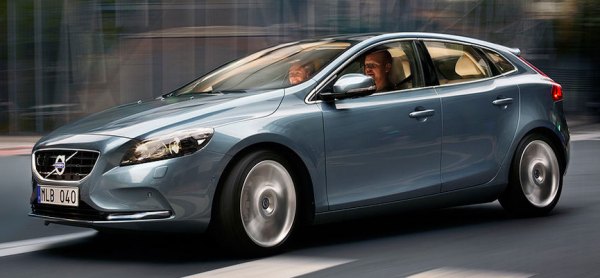
|
The V40 project started as far back as 2006, when Volvo was
still a subsidiary of Ford. Like the last generation S40 / V50, it is
derived from the Ford Focus platform – this time the C1. Volvo called
its version P1 instead, but it is basically the same thing. Owing to
financial constraints (as it was developed during the credit crunch
while Ford was seeking to offload Volvo) the development program was
delayed by 2 years, and its coverage was narrowed to a 5-door hatchback
only. As a result, the existing S40 sedan will die without a
replacement. The same can be said to the V50, too. Despite of the name
V40, the new car is purely a family hatchback instead of a station
wagon, so it is not going to be a direct replacement of V50. This will
inevitably limit its exposure to the global market. The company said as
much as 85 percent of the 90,000 V40s planned to be built annually will
be sold in Europe, leaving a small fraction to overseas market like
China, Japan and Australia. The lack of sedan version means USA and
Canada are out of the scope. Considering China has been increasingly
important to Volvo since its acquisition by Geely, will it build a
3-box version eventually? Maybe in longer term, but at the moment this
is not in the plan.
Despite of its close connection to Focus, the small Volvo looks nothing
like its cousin. Its exterior is far more tasteful. An especially long
and slim nose contributes to an aerodynamic appearance, whereas Volvo's
trademark stepped shoulders enhance the sense of rigidity. Some styling
elements are said to be inspired by the classic P1800ES shooting brake
of the 1970s, such as the kick at rear fender and the hexagonal
tailgate (also like C30). However, even without knowing the history we
can already tell it is a very handsome and distinctive design. If you
like the driving dynamics of Ford Focus but hate its bulldog mouth, the
V40 is probably the best solution.
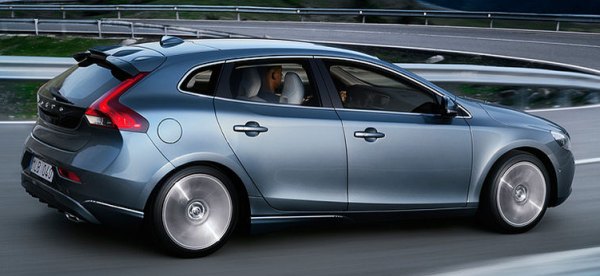
|
The V40 shares the same wheelbase with Focus, so it is not
among the roomiest in the C-segment field, but compare with BMW
1-Series, Audi A3 and even the new Mercedes A-class the amount of space
it offers is slightly more generous. Its 335 liters boot is average in
the class, but it has an adjustable floor to split the luggage
compartment into 2 levels – a nice touch that the German lack.
Moreover, the rear seats fold flat to form a large loading area.
The Focus-derived chassis is benefited from a few revisions, including
stronger piston rods at the MacPherson-strut front suspensions (to
resist
lateral force better), higher spec monotube dampers on the
control-blade multi-link rear suspensions (for faster response) and a
more rigidly mounted steering column (for uncorrupted steering). There
is even a sport suspension option with stiffer setup and 10 mm lower
ride height, but it is better to stick with the standard suspension as
it provides a truly smooth and quiet ride that marks the V40 out of its
German rivals as well as anything in the class. At the same time, it
provides good body control, grip and agility like the Ford Focus.
Moreover, it steers with even sharper response than its cheaper cousin.
That
makes the V40 both fun and comfortable to drive. It is really a
surprising achievement to Volvo!
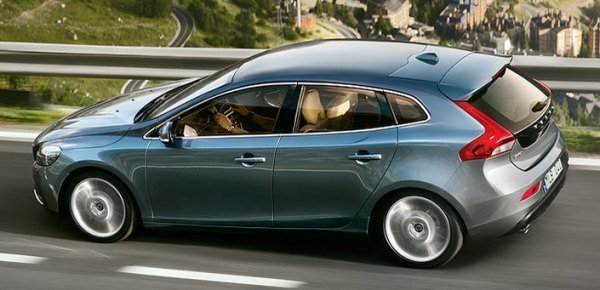 |
There is a wide range of engines to ensure you can find one
suitable. Half of them come from Ford, such as the 1.6-liter Ecoboost
(direct-injected turbo) engines with 150 hp (T3) or 180 hp (T4) and the
PSA-sourced 1.6-liter turbo diesel with 115 hp (D2). They mate with
either 6-speed manual or Ford's Powershift twin-clutch gearbox. The
rest of the engines are all Volvo's trademark 5-cylinder units,
including the 2.5-liter turbo petrol with 254 hp (T5) and 2.0-liter
turbo diesel with either 150 hp (D3) or 177 hp (D4). The T5 mates with
6-speed Geartronic automatic only, while the diesels are available with
both the 6-speed manual and Geartronic.
As much as we love the characterful noise and extra punch of five-pot
engines, they make the V40 a little nose-heavy and less agile. There is
also a bit torque steer if you rush the power to the front wheels.
Therefore the 180 hp T4 is our pick of the bunch. It is flexible,
smooth and willing to rev, as we found on many Ford models, and suits
the refined character of V40. Performance is quite brisk, too, with
0-60 mph achievable in 7.3 seconds and a top speed of 140 mph. That
said, the best selling engine is likely to be the 115 hp 1.6 diesel. It
might lack bottom-end response – something exaggerated by long gearing,
but once you rev it beyond 1800 rpm it becomes usefully gusty. All
engines get automatic stop-start function and a smart alternator for
brake energy regeneration, but the 1.6 diesel is clearly the greenest,
posting a spectacular 78.5 mpg in combined cycle and only 94 grams of CO2
per kilometer! That is even greener than BMW 116d EfficientDynamics and
Mercedes A180CDI.
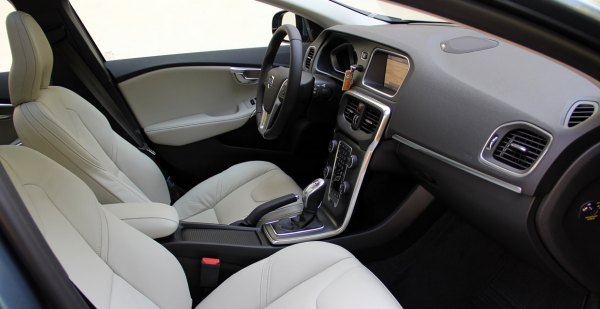
|
The green credential shows Volvo's commitment to social
responsibility. The same goes for its sophisticated safety
technologies. Ordinary cars – even as safe as Mercedes – protect only
their occupants, but the Volvo extends its protection to pedestrians.
Its City Safety collision avoidance system can brake the car to stop if
its radar and camera detect a pedestrian step in the way and is
predicted to be hit. This work with the car travelling at up to 31 mph
(50 km/h) thus could avoid the majority of pedestrian collisions
happened in busy urban area. At higher speed where collision is
unavoidable, the V40 has an innovative pedestrian airbag that inflates
from the trailing edge of the bonnet – which pops up slightly in a
fraction of a second – so to cushion the pedestrian from hitting the
hard points of the car. The V40 is set to be the first car that get
praised by non-motorists.
The cabin of V40 is a good example of Scandinavian design, being
tasteful yet functional. It is not terribly rich of expensive
materials, but the plastics are high quality and various places are
nicely decorated with chromed surrounds. As usual, the whole
environment looks clean and tidy. Controls are well positioned and easy
to use. The thin "floating console", which made its first appearance 8
years ago on the last S40, returns with a classier finish. The storage
cubby behind the console complements the otherwise lack of storage
spaces. Another stylish touch is a frameless rear-view mirror, which
shows its great attention to details. Equally outstanding is the new
(optional) TFT instrument, which offers a choice of 3 themes (Elegance,
Performance and Eco), each with different color, layout and information
displayed. This makes the V40's cabin more interesting than its German
rivals. As expected, Volvo's seats are comfy and excellent for
long-distance travel. There is really nothing to complain about its
cabin.
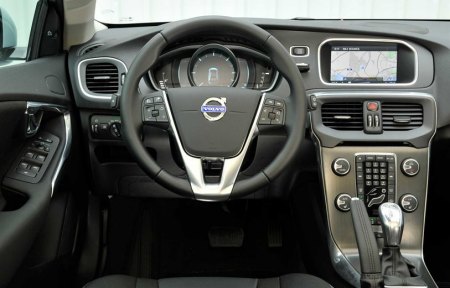
|
All in all, the new V40 is a remarkable product. Stylish,
tasteful, practical, comfortable, well-built, dynamically accomplished
and socially responsible, it is as great a premium hatchback can be. It
makes the new Audi A3 boring and BMW 1-Series horribly ugly. If
anything it lacks, that must be the keener pricing of the half-premium
Alfa Romeo Giulietta and Volkswagen Golf. If you think yourself deserve
a premium brand, then nothing could be better than this one.
|
Verdict:      |
|
|
|
|
|
|
|
|
|
|
V40 D2
|
2012
|
| Front-engined,
FWD |
| Steel monocoque |
| Mainly steel |
| 4369 / 1802 / 1420 mm |
| 2647 mm |
Inline-4, diesel
|
| 1560 cc |
DOHC 16 valves
|
| VTG turbo |
| CDI |
| 115 hp |
199 lbft
|
| 6-speed manual |
F: strut
R: control-blade multi-link
|
| - |
| 205/55R16 |
1401 kg
|
| 118 mph (c) |
11.7 (c)
|
| - |
|
V40 D4
|
2012
|
| Front-engined,
FWD |
| Steel monocoque |
| Mainly steel |
| 4369 / 1802 / 1420 mm |
| 2647 mm |
Inline-5, diesel
|
| 1984 cc |
DOHC 20 valves
|
| VTG turbo |
| CDI |
| 177 hp |
295 lbft
|
6-speed automatic
|
F: strut
R: control-blade multi-link
|
| - |
| 205/50R17 |
1498 kg
|
| 134 mph (c) |
7.8 (c)
|
| - |
|
V40 T4
|
2012
|
| Front-engined,
FWD |
| Steel monocoque |
| Mainly steel |
| 4369 / 1802 / 1420 mm |
| 2647 mm |
Inline-4
|
| 1596 cc |
DOHC 16 valves, DVVT
|
| Turbo |
| DI |
| 180 hp |
| 177 lbft (overboost 199 lbft) |
| 6-speed manual |
F: strut
R: control-blade multi-link
|
| - |
| 205/50R17 |
1399 kg
|
| 140 mph (c) |
7.3 (c)
|
| - |
|
|
|
|
|
Performance
tested by: -
|
|
|
|
|
|
|
|
|
Copyright©
1997-2012
by Mark Wan @ AutoZine
|
|